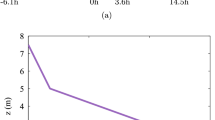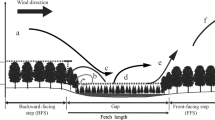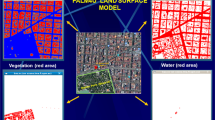Abstract
The Regional Atmospheric Modelling System (RAMS)-based Forest Large-Eddy Simulation (RAFLES) model is used to simulate the effects of large rectangular prism-shaped semi-porous barriers of varying densities under neutrally buoyant conditions. RAFLES model resolves flows inside and above forested canopies and other semi-porous barriers, and it accounts for barrier-induced drag on the flow and surface flux exchange between the barrier and the air. Unlike most other models, RAFLES model also accounts for the barrier-induced volume and aperture restriction via a modified version of the cut-cell coordinate system. We explicitly tested the effects of the numerical representation of volume restriction, independent of the effects of the drag, by comparing drag-only simulations (where we prescribed neither volume nor aperture restrictions to the flow), restriction-only simulations (where we prescribed no drag), and control simulations where both drag and volume plus aperture restrictions were included. Previous modelling and empirical work have revealed the development of important areas of increased uplift upwind of forward-facing steps, and recirculation zones downwind of backward-facing steps. Our simulations show that representation of the effects of the volume and aperture restriction due to the presence of semi-porous barriers leads to differences in the strengths and locations of increased-updraft and recirculation zones, and the length and strength of impact and adjustment zones when compared to simulation solutions with a drag-only representation. These are mostly driven by differences to the momentum budget of the streamwise wind velocity by resolved turbulence and pressure gradient fields around the front and back edges of the barrier. We propose that volume plus aperture restriction is an important component of the flow system in semi-porous environments such as forests and cities and should be considered by large-eddy simulation (LES).









Similar content being viewed by others
References
Adcroft A, Hill C, Marshall J (1997) Representation of topography by shaved cells in a height coordinate ocean model. Mon Weather Rev 125:2293–2315
Arakawa A, Lamb VR (1977) Computational design of the basic dynamical processes of the UCLA general circulation model. In: Chang J (ed) Methods in computational physics: advances in research and applications. Academic Press, New York, pp 174–265
Avissar R, Schmidt T (1998) An evaluation of the scale at which ground-surface heat flux patchiness affects the convective boundary layer using large-eddy simulations. J Atmos Sci 55:2666–2689
Avissar R, Eloranta EW, Gurer K, Tripoli GJ (1998) An evaluation of the large-eddy simulation option of the regional atmospheric modeling system in simulating a convective boundary layer: A FIFE case study. J Atmos Sci 55:1109–1130
Banerjee T, Katul G, Fontan S, Poggi D, Kumar M (2013) Mean flow near edges and within cavities situated inside dense canopies. Boundary-Layer Meteorol 149(19–41):19–41
Belcher SE, Jerram N, Hunt JCR (2003) Adjustment of a turbulent boundary layer to a canopy of roughness elements. J Fluid Mech 488:369–398
Bergen JD (1975) Air movement in a forest clearing as indicated by smoke drift. Agric Meteorol 15:165–179
Bohnenstengel SI, Evans S, Clark PA, Belcher SE (2011) Simulations of the London urban heat island. Q J R Meteorol Soc 137:1625–1640
Bohrer G, Wolosin M, Brady R, Avissar R (2007) A Virtual Canopy Generator (V-CaGe) for modeling complex heterogeneous forest canopies at high resolution. Tellus Ser B Chem Phys Meteorol 59B:566–576
Bohrer G, Nathan R, Katul GG, Walko RL, Avissar R (2008) Effects of canopy heterogeneity, seed abscission, and inertia on wind-driven dispersal kernels of tree seeds. J Ecol 96:569–580
Bohrer G, Zhu KP, Jones RL, Curtis PS (2013) Optimizing wind power generation while minimizing wildlife impacts in an urban area. PLOS One 8:1–8
Bohrerova Z, Bohrer G, Cho KD, Bolch MA, Linden KG (2009) Determining the viability response of Pinus taeda pollen under abiotic stresses typical to atmospheric conditions during long distance dispersal. Ecol Appl 19:656–667
Cassiani M, Katul GG, Albertson JD (2008) The effects of canopy leaf area index on airflow across forest edges: large eddy simulation and analytical results. Boundary-Layer Meteorol 126:433–460
Chamecki M (2013) Persistence of velocity fluctuations in non-Gaussian turbulence within and above plant canopies. Phys Fluid 25:1–14
Chamorro LP, Porte-Agel F (2009) Velocity and surface shear stress distributions behind a rough-to-smooth surface transition: a simple new model. Boundary-Layer Meteorol 130:29–41
Deardorff JW (1980) Stratocumulus-capped mixed layers derived from a 3-dimensional model. Boundary-Layer Meteorol 18:495–527
Detto M, Katul GG, Siqueira M, Juang J-H, Stoy PC (2008) The structure of turbulence near a tall forest edge: the backward facing step flow analogy revisited. Ecol Appl 18:1420–1435
Dupont S, Brunet Y (2006) Simulation of turbulent flow in an urban forested park damaged by a windstorm. Boundary-Layer Meteorol 120:133–161
Dupont S, Brunet Y (2008a) Edge flow and canopy structure: a large-eddy simulation study. Boundary-Layer Meteorol 126:51–71
Dupont S, Brunet Y (2008b) Impact of forest edge shape on tree stability: a large-eddy simulation study. Forestry 81:299–315
Dupont S, Brunet Y, Jarosz N (2006) Eulerian modelling of pollen dispersal over heterogeneous vegetation canopies. Agric Meteorol 141:82–104
Folkard AM (2011) Flow regimes in gaps within stands of flexible vegetation: laboratory flume simulations. Environ Fluid Mech 11:289–306
Fontan S, Katul GG, Poggi D, Manes C, Ridolfi L (2013) Flume experiments on turbulent flows across gaps of permeable and impermeable boundaries. Boundary-Layer Meteorol 147:21–39
Gardiner BA, Stacey GR, Belcher RE, Wood CJ (1997) Field and wind tunnel assessments of the implications of respacing and thinning for tree stability. Forestry 70:233–252
Goodrick SL, Achtemeier GL, Larkin NK, Liu Y, Strand TM (2013) Modelling smoke transport from wildland fires: a review. Int J Wildland Fire 22:83–94
Haltiner GJ, Williams RT (1980) Numerical prediction and dynamic meteorology. Wiley, New York, 477 pp
Harman IN, Belcher SE (2006) The surface energy balance and boundary layer over urban street canyons. Q J R Meteorol Soc 132:2749–2768
Hattori H, Nagano Y (2010) Investigation of turbulent boundary layer over forward-facing step via direct numerical simulation. Int J Heat Fluid Flow 31:284–294
Huang J, Cassiani M, Albertson JD (2011) Coherent turbulent structures across a vegetation discontinuity. Boundary-Layer Meteorol 140:1–22
Klemp JB, Wilhelmson RB (1978) Simulation of 3-dimensional convective storm dynamics. J Atmos Sci 35:1070–1096
Liu J, Chen JM, Black TA, Novak MD (1996) E-epsilon modelling of turbulent air flow downwind of a model forest edge. Boundary-Layer Meteorol 77:21–44
Macdonald RW, Carter Shofield S (2002) Physical modeling of Urban roughness using arrays of regular elements. Water Air Soil Pollut 2:541–554
Markfort CD, Perez ALS, Thill JW, Jaster DA, Porte-Agel F, Stefan HG (2010) Wind sheltering of a lake by a tree canopy or bluff topography. Water Resour Res 46:W03530
Maurer KD, Bohrer G, Medvigy D, Wright SJ (2013) The timing of abscission affects dispersal distance in a wind-dispersed tropical tree. Funct Ecol 27:208–218
Paik J, Sotiropoulos F, Porte-Agel F (2009) Detached eddy simulation of flow around two wall-mounted cubes in tandem. Int J Heat Fluid Flow 30:286–305
Panferov O, Sogachev A (2008) Influence of gap size on wind damage variables in a forest. Agric Meteorol 148:1869–1881
Patton EG, Shaw RH, Judd MJ, Raupach MR (1998) Large-eddy simulation of windbreak flow. Boundary-Layer Meteorol 87:275–306
Patton EG, Sullivan PP, Ayotte KW (2006) Flow and transport above and within forests in complex topography. In: Integrated land-ecosystem atmosphere study conference, Boulder, 376 pp
Poggi D, Porporato A, Ridolfi L, Albertson JD, Katul GG (2004) The effect of vegetation density on canopy sub-layer turbulence. Boundary-Layer Meteorol 111:565–587
Prueger JH, Eichinger WE, Hipps LE, Hatfield JL, Cooper DI (2008) Air-flow distortion and turbulence statistics near an animal facility. Atmos Environ 42:3301–3314
Santiago JL, Martin F, Cuerva A, Bezdenejnykh N, Sanz-Andrés A (2007) Experimental and numerical study of wind flow behind windbreaks. Atmos Environ 41:6406–6420
Schlegel F, Stiller J, Bienert A, Maas HG, Queck R, Bernhofer C (2012) Large-eddy simulation of inhomogeneous canopy flows using high resolution terrestrial laser scanning data. Boundary-Layer Meteorol 142:223–243
Seraphin A, Guyenne P (2008) A flume experiment on the adjustment of the mean and turbulent statistics to a transition from short to tall sparse canopies. Boundary-Layer Meteorol 129:47–64
Shaw RH, Patton EG (2003) Canopy element influences on resolved- and subgrid-scale energy within a large-eddy simulation. Agric Meteorol 115:5–17
van Hooff T, Blocken B (2010) Coupled urban wind flow and indoor natural ventilation modelling on a high-resolution grid: a case study for the Amsterdam ArenA stadium. Environ Modell Softw 25:51–65
Walko RL, Avissar R (2008) The Ocean-Land-Atmosphere Model (OLAM). Part II: formulation and tests of the nonhydrostatic dynamic core. Mon Weather Rev 136:4045–4062
Winstral A, Marks D, Gurney R (2013) Simulating wind-affected snow accumulations at catchment to basin scales. Adv Water Resour 55:64–79
Wolfe GM, Thornton JA (2011) The Chemistry of Atmosphere-Forest Exchange (CAFE) Model—Part 1: model description and characterization. Atmos Chem Phys 11:77–101
Yang B, Raupach M, Shaw RH, Paw U KT, Morse AP (2006) Large-eddy simulation of turbulent flow across a forest edge. Part I: flow statistics. Boundary-Layer Meteorol 119:377–412. doi:10.1007/s10546-006-9083-3
Yue W, Parlange MB, Meneveau C, Zhu W, van Hout R, Katz J (2007) Large-eddy simulation of plant canopy flows using plant-scale representation. Boundary-Layer Meteorol 124:183–203
Acknowledgments
We thank Robert Walko for developing the implementation of the cut-cell approach in RAMS and assisting in implementing it in RAFLES model. Simulations were conducted at The Ohio Supercomputer Centre. The work was conducted with support from the U.S. Department of Agriculture, National Institute for Food & Agriculture (NIFA) - Air Quality grant CSREES-OHOR-2009-04566 and Forest Service Northern Research Station, East Lansing, MI, Joint Research Venture #10-JV-11242302-013. Further developments of RAFLES model were funded in part by NSF grants # DEB-0911461 and CBET-1033451. Any opinions, findings, and conclusions or recommendations expressed in this material are those of the authors and do not necessarily reflect the views of the National Science Foundation.
Author information
Authors and Affiliations
Corresponding author
Rights and permissions
About this article
Cite this article
Chatziefstratiou, E.K., Velissariou, V. & Bohrer, G. Resolving the Effects of Aperture and Volume Restriction of the Flow by Semi-Porous Barriers Using Large-Eddy Simulations. Boundary-Layer Meteorol 152, 329–348 (2014). https://doi.org/10.1007/s10546-014-9923-5
Received:
Accepted:
Published:
Issue Date:
DOI: https://doi.org/10.1007/s10546-014-9923-5




